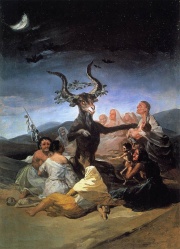Witch
From The Art and Popular Culture Encyclopedia
| Revision as of 09:26, 23 March 2014 Jahsonic (Talk | contribs) ← Previous diff |
Revision as of 06:24, 26 June 2020 Jahsonic (Talk | contribs) Next diff → |
||
| Line 1: | Line 1: | ||
| + | {| class="toccolours" style="float: left; margin-left: 1em; margin-right: 2em; font-size: 85%; background:#c6dbf7; color:black; width:30em; max-width: 40%;" cellspacing="5" | ||
| + | | style="text-align: left;" | | ||
| + | "In the following pages I have endeavoured to show the [[witch]] as she really was – an evil liver: a social pest and parasite: the devotee of a loathly and obscene creed: an adept at poisoning, blackmail, and other creeping crimes: a member of a powerful secret organisation inimical to Church and State: a blasphemer in word and deed, swaying the villagers by terror and superstition: a charlatan and a quack sometimes: a bawd: an abortionist: the dark counsellor of lewd court ladies and adulterous gallants: a minister to vice and inconceivable corruption, battening upon the filth and foulest passions of the age."--''[[The History of Witchcraft and Demonology]]'' (1926) by Montague Summers | ||
| + | |} | ||
| [[Image:Witches' sabbath.jpg|thumb|''[[Witches' Sabbath (Goya, 1798)|Witches' Sabbath]]'' (1798) by [[Francisco Goya]]]] | [[Image:Witches' sabbath.jpg|thumb|''[[Witches' Sabbath (Goya, 1798)|Witches' Sabbath]]'' (1798) by [[Francisco Goya]]]] | ||
Revision as of 06:24, 26 June 2020
|
"In the following pages I have endeavoured to show the witch as she really was – an evil liver: a social pest and parasite: the devotee of a loathly and obscene creed: an adept at poisoning, blackmail, and other creeping crimes: a member of a powerful secret organisation inimical to Church and State: a blasphemer in word and deed, swaying the villagers by terror and superstition: a charlatan and a quack sometimes: a bawd: an abortionist: the dark counsellor of lewd court ladies and adulterous gallants: a minister to vice and inconceivable corruption, battening upon the filth and foulest passions of the age."--The History of Witchcraft and Demonology (1926) by Montague Summers |
|
Related e |
|
Featured: |
A witch refers to a man (archaic) or a woman who practises witchcraft. It can also refer to an ugly or unpleasant woman.
Contents |
Folklore
Powers typically attributed to European witches include turning food poisonous or inedible, flying on broomsticks or pitchforks, casting spells, cursing people, making livestock ill and crops fail, and creating fear and local chaos.
Flying
In the past, it was believed that witches used a mixture of belladonna, opium poppy, and other plants, typically poisonous (such as monkshood and poison hemlock) in flying ointment they applied to help them fly to gatherings with other witches. Carlo Ginzburg and others have argued that flying ointments were preparations meant to encourage hallucinatory dreaming; a possible explanation for the inclusion of belladonna and opium poppy in flying ointments concerns the known antagonism between tropane alkaloids of belladonna (specifically scopolamine) and opiate alkaloids in the opium poppy, Papaver somniferum (specifically morphine), which produces a dream-like waking state. This antagonism was known in folk medicine, discussed in eclectic (botanical) medicine formularies The antagonism between opiates and tropanes is the original basis of the Twilight Sleep that was provided to Queen Victoria to deaden pain as well as consciousness during childbirth.
Witches in art
Renaissance
- The Four Witches
- Witch Riding Backwards on a Goat by Durer
- Hans Baldung Grien's witches
- Depart pour le Sabat by Teniers
18th century
- Witches' Sabbath (1798) by Francisco Goya
19th century
References
See also


